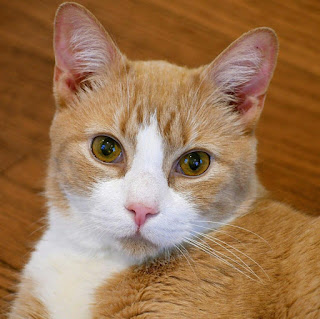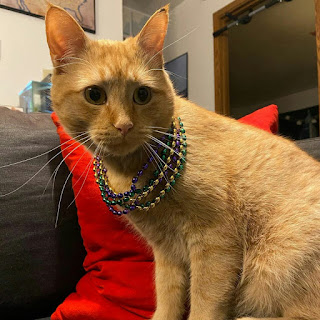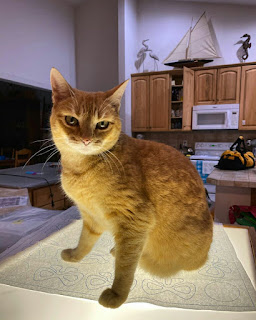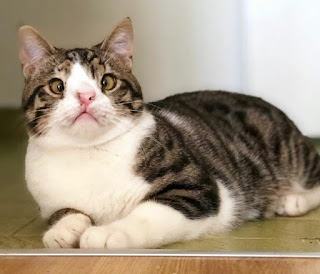Cat Years to Human Years
Converting between cat years and human years isn't as simple as employing a factor of seven (as some people think with dogs, and sometimes cats). The main reason is that cats mature quickly within the first few years of life.
To convert cat age to the same human age, an accepted method is to feature 15 years for the primary year of life. Then add 10 years for the second year of life. After that, add 4 years for each cat year. This means that by year two, a cat has matured to about an equivalent as a 25 year old human.
Not everyone agrees on the same conversion formula. For a rather different calculation, the Cat Bible, a book by Tracie Hotchner, provides the subsequent list:
1-month-old kitten = 6-month-old human baby
3-month-old kitten = 4-year-old child
6-month-old kitten = 10 human years old
8-month-old kitten = 15-year-old human
1-year-old cat = adulthood, the equivalent of 18 human years
2 human years = 24 cat years
4 human years = 35 cat years
6 human years = 42 cat years
8 human years = 50 cat years
10 human years = 60 cat years
12 human years = 70 cat years
14 human years = 80 cat years
16 human years = 84 cat years
There’s no reliable scientific thanks to calculate the connection between human and cat years, but it’s generally agreed that the primary two years of a cat’s life are roughly equal to the primary 25 of a human’s, and after this, each additional year is around four ‘cat years’. This means if your cat is six years old, their equivalent cat age in human years are going to be around 41.
According to some sources, the world’s oldest cat lived to be 34 – that’s 153 in cat years! Some breeds will live longer than others – for instance , on the average Siamese and Manx breeds are said to measure the longest, so could reach a ripe age in human years!
Converting between cat years and human years isn't as simple as employing a factor of seven (as some people think with dogs, and sometimes cats). The main reason is that cats mature quickly within the first few years of life.
To convert cat age to the same human age, an accepted method is to feature 15 years for the primary year of life. Then add 10 years for the second year of life. After that, add 4 years for each cat year. This means that by year two, a cat has matured to about an equivalent as a 25 year old human.
Not everyone agrees on the same conversion formula. For a rather different calculation, the Cat Bible, a book by Tracie Hotchner, provides the subsequent list:
1-month-old kitten = 6-month-old human baby
3-month-old kitten = 4-year-old child
6-month-old kitten = 10 human years old
8-month-old kitten = 15-year-old human
1-year-old cat = adulthood, the equivalent of 18 human years
2 human years = 24 cat years
4 human years = 35 cat years
6 human years = 42 cat years
8 human years = 50 cat years
10 human years = 60 cat years
12 human years = 70 cat years
14 human years = 80 cat years
16 human years = 84 cat years
There’s no reliable scientific thanks to calculate the connection between human and cat years, but it’s generally agreed that the primary two years of a cat’s life are roughly equal to the primary 25 of a human’s, and after this, each additional year is around four ‘cat years’. This means if your cat is six years old, their equivalent cat age in human years are going to be around 41.
According to some sources, the world’s oldest cat lived to be 34 – that’s 153 in cat years! Some breeds will live longer than others – for instance , on the average Siamese and Manx breeds are said to measure the longest, so could reach a ripe age in human years!
How to Calculate Cat Years to Human Years
A popular misconception is that cats age seven years (in human years) for every civil year . In fact, feline aging is far more rapid during the primary two years of life. A cat reaches the approximate human age of 15 during his first year, then 24 at age 2. Each year thereafter, a cat ages approximately four cat years for each civil year . Thus, a cat who is 5 in cat years would be approximately 36 in human years.
Indicators of a Cat’s Age
If you’ve taken during a stray cat or adopted a cat whose age is unknown, there are some ways to work out her age in cat years. Here are some things vets check to urge a general sense of how old a cat is:
A Cat’s Teeth: Teeth are an excellent indicator of a cat’s age in cat years. Older cats tend to possess more staining than younger cats, assuming the previous owner was negligent in brushing the cat’s teeth. And a kitten’s teeth first are available between two to four weeks; their more permanent set appears at around four months aged . So if you open a cat’s mouth and find permanent, white teeth, the feline is probably going to be around a year old. Some yellowing might place the cat between 1 and a couple of , and tartar build-up on all the teeth indicates that the cat might be between 3 and 5. Missing teeth may mean you've got a senior cat on your hands.
A Cat’s Muscle Tone: Younger cats are more likely to possess some muscle definition from their higher activity level. Older cats are usually a touch bonier and should have some extra skin hanging or protruding shoulder blades.
A Cat’s Coat: The condition of a cat’s coat is another great indicator of a kitty’s age in cat years. Kittens and younger cats usually have soft, fine coats, whereas older cats tends to possess thicker, coarser fur.
A senior cat may display grays or patches of white.
A Cat’s Eyes: Bright, clear eyes without tearing or eye discharge are common in younger cats.
A cat with some cloudiness in their eyes is probably going to be 12 years old approximately . While inspecting the lens, also examine the iris of the attention . Young cats have smooth irises, while the iris of an old cat can sometimes appear somewhat jagged.
A Cat’s Life Span
Felines are generally quite long-lived, though mileage varies counting on owner maintenance and genetic predisposition. In a few documented cases, cats have exceeded 30 years in age. Typically, indoor cats may live 12 to 18 years, with many surviving into their 20s.
Outdoor Cats anticipation — How Long Do Outdoor Cats Live, in Cat Years?
Outdoor cats can have a significantly shorter lifetime then indoor-only cats, often living only two to 5 years. Pet parents in urban and suburban areas are strongly encouraged to stay their cats indoors.
The nagging question about cat years and the way long cats really live may be a common one; we get attached to our pets and that we are interested by their world, how they perceive life, and how long they will be around, it's only natural.
To put out a really general number, the typical cat lifespan is between 10 and 16 years. Although, the oldest known cat was tons older than simply 16 (he died at 36, because the legend goes), in order that number is merely a suggestion , although it is fairly accurate. If you wanted to understand about the overall anticipation of your cat, there it's for you in black and white. However, with a touch proper care we will all extend the lifetime of our cats to a reasonably good degree too.
Here's another fun incontrovertible fact that people are nearly always interested by , 1 cat year equals roughly 7 human years, so if your cat is 4 years old, they're roughly 28 in human years, in their prime so to talk . More important than these cat factoids however is the fact that we can indeed extend the lifespan of our cats with some fairly simple common sense things.
First of all, did you realize that an inside cat lives tons longer than an outside cat? It's true, an inside cat comes into to contact with much fewer threats (other animals, fleas, infections, diseases) than an outside cat. Now, if your cat is already wont to the outdoor it's going to be difficult to urge them to vary , but simply realize that this easy step does, generally , extend life.
Also, spraying or neutering your cat statistically lengthens the lifetime of that cat also . This is sensible as if they're sexually neutral they typically won't put themselves into compromising positions. It may seem cruel to some (and you've got the proper to think that) but if extension of life is your concern then spraying and neutering should be part of your plan.
Taking care of your cat's general health is the last part of the plan. And this involves being aware of the illnesses (cardiovascular disease, diabetes, kidney problems) cats will generally suffer as they get into old age, knowing about them and treating them quickly could be the difference between an early death and a long life.
Many people are finding that their cat's bodies are tons like their own, a cat needs good nutrition, exercise, and clean water so as to function their best; a body which functions well just simply lives longer.
What constitutes good nutrition will vary depending on who you talk to but many people believe that a raw meat diet (with organically raised meat, of course) is top of the line. Mineral water is presumably best for drinking, avoid water if you reside in an populated area , and confirm that your cat gets tons of exercise and play. If we do that , our cherished cat years will stretch out and truly be blessed and healthy






Comments
Post a Comment